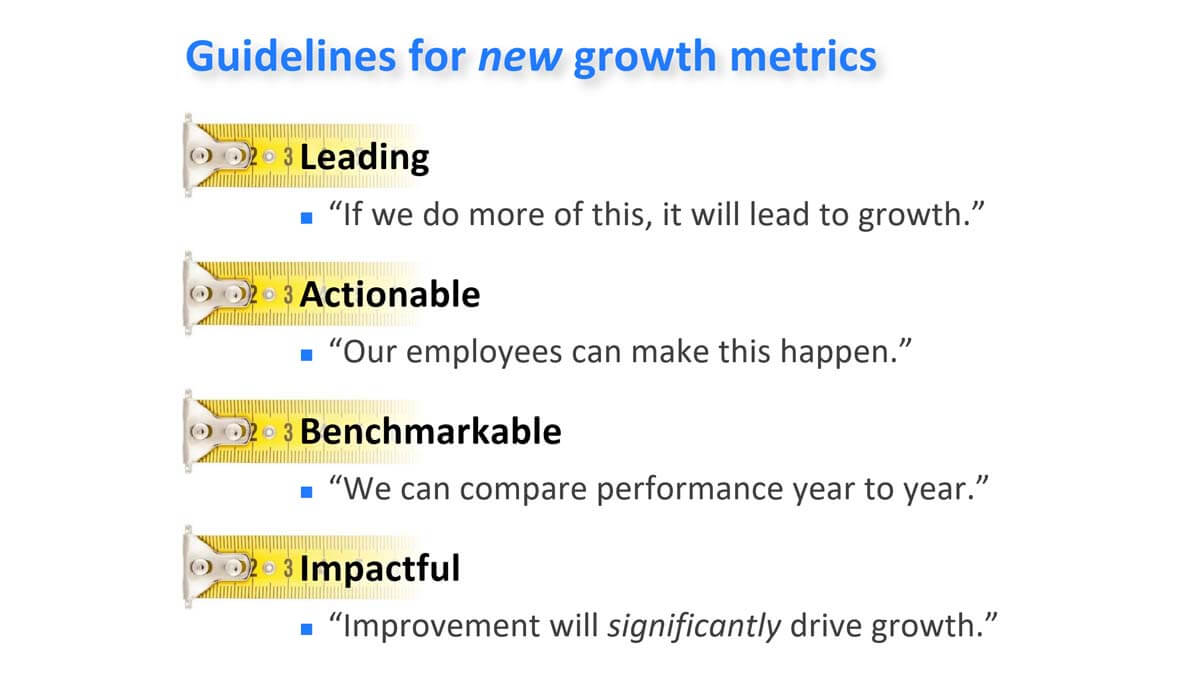New Product Success is a metric for current projects. Learning Success—which measures skill-building progress—is a metric for future projects. Most companies just consider New Product Success. Worse, they only look at ultimate metrics, e.g., sales. If they also used intermediate metrics, they’d have enough time to apply what they learned from these metrics.
More in white paper, www.newinnovationmetrics.com
The Vitality Index (% of sales from new products) is helpful, but it suffers from being a lagging indicator. So how would you supplement it? Any new innovation metric you adopt should satisfy 4 rules: 1) Leading: “If we do more of this it will lead to growth.” 2) Actionable: “Our employees can make this happen.” 3) Benchmarkable: “We can compare to others and year-to-year.” 4) Impactful: “Improvement will significantly drive growth.
Here are two new innovation metrics that satisfy all four rules: Growth Driver Index (GDI) and Commercial Confidence Index (CCI). These measure your growth capabilities and evidence-based customer insight, respectively. (See white paper, New Innovation Metrics.)
More in 2-minute video, Employ new growth metrics
Everyone wants to use metrics to monitor their innovation. That's fine… but unless you’re using “intermediate” metrics, you could be missing 3 qualities of a good metric: 1) predictive, 2) insightful, and 3) actionable. Consider these 12 intermediate metrics for your business. ... Read More
1. The “Why” problem: Today’s most popular metric, the Vitality Index (% of sales from new products) doesn’t tell you why your % is going up or down. 2. The “When” problem: The lag time in your feedback loop is too long: Changes you make in the front-end-of-innovation will take years to generate significant revenue. 3. The “What” problem: The Vitality index focuses on your results. You need metrics that focus on your capabilities. Only by building these can you have confidence that you’ll improve your innovation results.
More in article, 3 Problems with Innovation Metrics
The Vitality Index–% of revenue from new products—is the most popular innovation metric today. But the feedback loop is soooo long. Let’s say you implement a new practice in the front-end of innovation, like improved customer interviews. It will take years for those projects to be developed, launched and register significant sales. This is like turning up your thermostat and having the furnace come on. Next week. For more download our white paper, New Innovation Metrics.
More in article, 3 Problems with Innovation Metrics
When you turn up your thermostat, the temperature rises to the set point and quickly shuts off your furnace. Imagine if you had an 8-hour “feedback loop” before your furnace got the message. Even if you try new VOC approaches in the front end—but all your metrics occur after product launch—your feedback loop takes years. That’s no way to improve, is it?
More in article, 3 Problems with Innovation Metrics (Originally published in B2B Organic Growth Newsletter).
A fine innovation metric is the vitality index… % of total sales from new products (usually launched in the last 3 or 5 years). But it doesn’t tell you why your % is going up or down, does it? Sure, you can see which new products contributed… but you need to uncover the underlying reasons driving results. Otherwise you’re just watching from the bleachers.
More in article, 3 Problems with Innovation Metrics (Originally published in B2B Organic Growth Newsletter).
New Product Success is a metric for current projects. Learning Success—which measures skill-building progress—is a metric for future projects. Most companies just consider New Product Success. Worse, they only look at ultimate metrics, e.g. sales. If they also used intermediate metrics, they’d have enough time to apply what they learned from these metrics.
More in article, 3 Problems with Innovation Metrics. (Originally published in B2B Organic Growth Newsletter)








